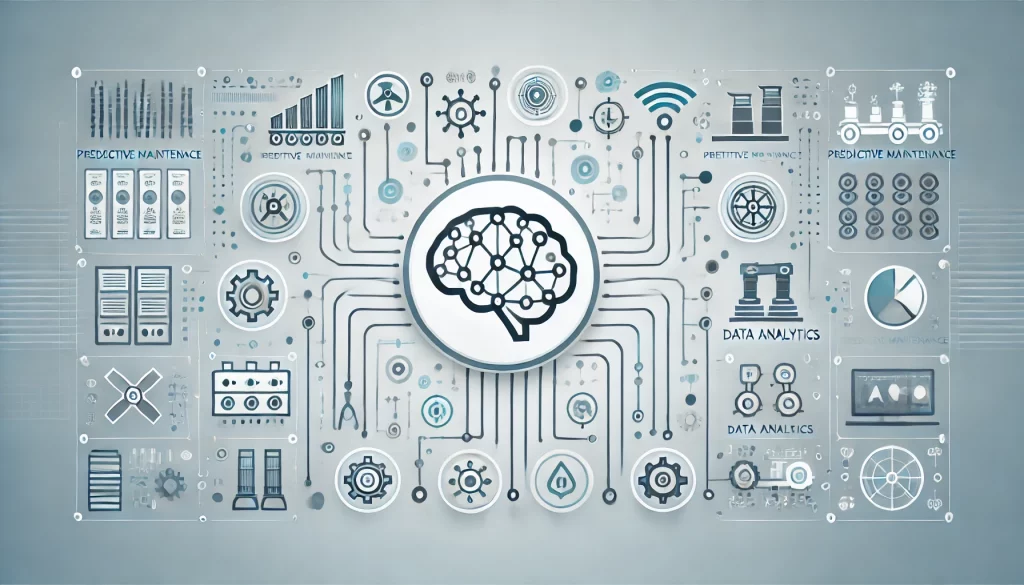Making informed decisions is getting more critical than ever. The vast amount of data generated every day holds the potential to provide invaluable insights, but only if it’s harnessed effectively. This is where Artificial Intelligence (AI) comes into play. By leveraging AI, businesses can transform raw data into actionable insights, enabling more precise, faster, and data-driven decision-making processes.
What is AI in Data-Driven Decision Making?
Artificial Intelligence (AI) is the technology that enables machines to mimic human intelligence, allowing them to think, learn, and adapt in ways similar to humans. When applied to data-driven decision making, AI helps analyze large datasets, identify patterns, and make predictions that guide business decisions. The most common AI techniques used in decision making include Machine Learning, Natural Language Processing (NLP), and Predictive Analytics. These tools allow businesses to dig deeper into their data, uncovering trends and insights that might otherwise remain hidden.
Why Use AI for Data-Driven Decision Making?
AI can process vast amounts of data far more quickly and accurately than a human ever could. This speed and efficiency allow businesses to react in real-time, making decisions based on the latest available data. AI’s predictive capabilities mean that businesses can not only understand what is happening now but also anticipate future trends and outcomes.
1. Collect and Prepare High-Quality Data
The foundation of any successful AI-driven decision-making process is high-quality data. Without accurate, relevant, and clean data, even the most sophisticated AI models will fail to deliver meaningful insights.
Importance of High-Quality Data
Data is the fuel that powers AI. If your data is flawed, incomplete, or biased, the decisions your AI makes will be too. Ensuring data integrity is the first step toward successful AI implementation.
Data Collection Best Practices
Begin by identifying the types of data you need. This might include structured data, such as sales figures or customer demographics, as well as unstructured data like social media posts or customer feedback. Automated tools can help streamline the data collection process, ensuring that you gather the most relevant information.
Data Cleaning and Preprocessing
Once you’ve collected your data, the next step is to clean and preprocess it. This involves correcting errors, filling in missing values, and ensuring consistency across datasets. Automated tools can again be invaluable here, helping to identify and correct issues that could compromise your AI’s performance.
2. Utilize AI Techniques for Advanced Data Analysis
With your data prepared, the next step is to leverage AI techniques to analyze it. AI can handle large volumes of data, uncovering patterns and insights that would be impossible for humans to detect.
AI Techniques for Analyzing Data
Machine Learning algorithms can identify trends and correlations within your data, while NLP can be used to analyze unstructured text data, such as customer reviews or social media posts. Predictive Analytics, on the other hand, can help forecast future trends, allowing you to make proactive decisions.
Tools and Platforms for Advanced AI Analysis
There are many AI tools and platforms available that can help you analyze your data. When choosing a tool, consider factors such as ease of use, scalability, and integration with your existing systems.
Real-World Applications
AI is already being used by businesses to improve decision-making across a range of industries. For example, retailers are using AI to predict consumer trends and optimize inventory levels, while manufacturers are using it to improve operational efficiency and reduce downtime.
3. Automate Routine Decision-Making Tasks
One of the biggest advantages of AI is its ability to automate routine, time-consuming tasks. This not only increases efficiency but also frees up human decision-makers to focus on more strategic tasks.
Benefits of Automating Decision-Making
By automating routine decisions, businesses can ensure consistency and reliability while reducing the risk of human error. For example, AI can automatically analyze sales data and make decisions about stock levels or pricing, allowing human employees to focus on strategic planning and customer relationships.
AI-Powered Automation in Action
In practice, AI can be used to automate a wide range of decision-making tasks, from data gathering and analysis to the execution of routine business processes. For example, AI can automate the process of screening resumes and shortlisting candidates for a job, freeing up HR professionals to focus on interviewing and onboarding.
Implementing AI Automation
When implementing AI automation, start by identifying which tasks are most suitable for automation. Look for tasks that are repetitive, time-consuming, and involve large amounts of data. Once you’ve identified these tasks, you can begin integrating AI into your processes. Remember, successful AI automation requires not only the right technology but also the right people and processes in place to manage it.
4. Enhance Decision Accuracy with AI Recommendations
While human judgment is invaluable, AI can enhance decision accuracy by providing data-driven recommendations based on rigorous analysis.
The Value of AI in Decision Accuracy
AI can analyze data without the biases and emotional influences that can sometimes affect human decision-making. By combining AI’s analytical power with human intuition, businesses can make more accurate and reliable decisions.
AI-Enhanced Decision-Making Process
The process typically involves AI analyzing data to generate insights, which are then reviewed by human decision-makers who use their judgment to make the final decision. This hybrid approach combines the best of both worlds, ensuring that decisions are both data-driven and contextually informed.
Case Studies on AI Improving Decision Accuracy
For example, in the financial sector, AI is being used to improve investment decisions by analyzing market trends and predicting future performance. In healthcare, AI is helping doctors make more accurate diagnoses by analyzing patient data and comparing it with thousands of similar cases.
5. Continuously Monitor and Adapt Decisions
The business environment is constantly changing, and so too should your decision-making processes. AI can help by continuously monitoring the outcomes of decisions and providing feedback that allows you to adapt and improve over time.
The Importance of Continuous Monitoring
AI can track key performance indicators (KPIs) in real-time, allowing businesses to monitor the effectiveness of their decisions and make adjustments as needed. This continuous feedback loop is essential for ensuring that your AI models remain relevant and effective over time.
AI for Adaptive Decision-Making
In addition to monitoring, AI can also suggest real-time adjustments based on new data. For example, if sales of a particular product are falling, AI might suggest changes to pricing or marketing strategy to boost performance.
Tools for Continuous AI Monitoring
There are several tools available that can help you monitor and adapt your AI-driven decision-making processes. These tools can track a range of metrics, from sales performance to customer satisfaction, and provide insights that help you optimize your decisions over time.

Challenges of Using AI in Data-Driven Decision Making
Although AI brings significant benefits, it also presents certain challenges. These include data privacy and security concerns, bias in AI algorithms, high costs of implementation, and the complexity of AI systems.
Common Challenges
- Data Privacy and Security: Ensuring that your data is handled securely and in compliance with regulations is a major concern.
- Bias in AI Algorithms: AI models are only as good as the data they’re trained on, and if that data is biased, the decisions they make will be too.
- High Costs of Implementation: Implementing AI can be expensive, especially for smaller businesses.
- Complexity of AI Systems: Managing and understanding AI systems can be challenging, especially for businesses without a dedicated data science team.
Overcoming These Challenges
To overcome these challenges, businesses should focus on ensuring ethical AI use, adopting cost-effective strategies, and simplifying the deployment of AI systems. It’s also important to work with partners who understand the complexities of AI and can provide the support you need.
Best Practices for Leveraging AI in Decision Making
To get the most out of AI, it’s important to follow best practices. These include starting small and scaling up, focusing on high-impact areas, maintaining data quality, regularly updating and training AI models, and ensuring transparency and explainability in AI decisions.
Start Small and Scale Up
Begin by implementing AI in a single area of your business, then scale up as you become more comfortable with the technology. This approach minimizes risk and allows you to learn and adapt as you go.
Focus on High-Impact Areas
Identify the areas of your business where AI can have the greatest impact. This might be in operations, customer service, or marketing, depending on your specific needs.
Maintain Data Quality
As mentioned earlier, data quality is critical to the success of your AI initiatives. Ensure that your data is relevant, accurate, and up-to-date.
Regularly Update and Train AI Models
AI models need to be regularly updated and trained to remain effective. This involves feeding them new data and adjusting their algorithms to reflect changes in your business environment.
Ensure Transparency and Explainability
Finally, it’s important to ensure that your AI decisions can be explained and understood by all stakeholders. This not only builds trust but also ensures that your AI models are being used ethically and responsibly.
The Future of AI in Data-Driven Decision Making
Looking ahead, the role of AI in decision-making is only set to grow. Emerging trends include the integration of AI with Big Data and IoT (Internet of Things), which will enable even more real-time, data-driven decisions. As AI technology continues to evolve, businesses that embrace it will be better positioned to stay ahead of the competition.
Emerging AI Trends
- AI and Big Data Integration: AI will increasingly be used to analyze large datasets, providing deeper insights and more accurate predictions.
- AI in Real-Time Decision Making: The ability to make real-time decisions based on live data will become increasingly important as businesses seek to remain agile and responsive.
- AI and IoT: The combination of AI and IoT will enable businesses to make smarter decisions by providing real-time data from connected devices.
Predictions for AI Adoption in Businesses
As AI becomes more accessible and affordable, its adoption will continue to grow across all industries. Businesses that invest in AI today will be better positioned to take advantage of these future trends.
Preparing for the Future
To prepare for the future, businesses should start by investing in AI tools and training their teams on how to use them. They should also keep an eye on emerging trends and be ready to adapt their AI strategies as needed.
Ethical Considerations in AI Decision Making
As AI becomes more prevalent, it’s important to consider the ethical implications of its use. This includes ensuring fairness and reducing bias in AI algorithms, complying with legal and regulatory requirements, and making sure that AI decisions can be explained and understood by all stakeholders.
Importance of Ethical AI
Ethical AI is not just about doing the right thing; it’s also about building trust with your customers and stakeholders. By ensuring that your AI models are fair and transparent, you can build a stronger, more sustainable business.
Ensuring Fairness and Reducing Bias
To reduce bias in AI algorithms, it’s important to use diverse datasets and regularly audit your models to ensure they are making fair decisions.
Legal and Regulatory Compliance
AI is subject to a range of legal and regulatory requirements, including data privacy laws. Make sure your AI initiatives are compliant with all relevant regulations.
Case Studies of Ethical AI Use
For example, in the financial sector, AI is being used to improve credit scoring by reducing bias and ensuring that all applicants are treated fairly. In healthcare, AI is helping to ensure that treatment decisions are based on objective data rather than subjective judgment.
Conclusion
In conclusion, AI has the potential to revolutionize decision-making processes across all industries. By following the key ideas outlined in this article—collecting and preparing high-quality data, utilizing AI techniques for advanced analysis, automating routine tasks, enhancing decision accuracy, and continuously monitoring and adapting decisions—businesses can make smarter, more informed decisions that drive success.
Call to Action
If you’re ready to start leveraging AI for data-driven decision-making, now is the time to act. Explore the AI tools and platforms available to your business, and consider partnering with experts who can help you navigate the complexities of AI implementation. Book a meeting with Be Digital.
Additional Resources
For more information on how to implement AI in your business, check out our related articles on “AI-Powered Predictive Maintenance” and “Transforming Customer Experience with AI.
Join our growing community!
Follow us on LinkedIn, X, and Facebook to stay updated on the latest AI trends, insights, and success stories.


